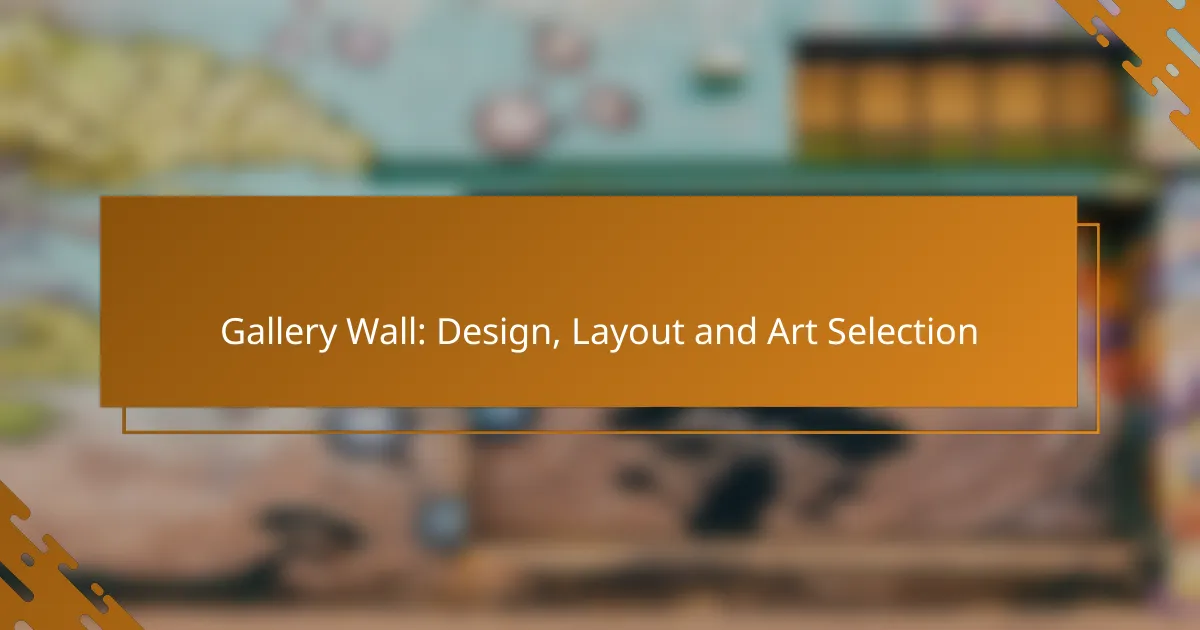Creating a gallery wall is an exciting way to showcase your personal style through art. By thoughtfully considering design elements such as balance, color, and theme, you can achieve a visually appealing arrangement. Explore various layout options, from grid to salon styles, and select pieces that resonate with you to craft a dynamic and cohesive display.

How to design a gallery wall in your home?
Designing a gallery wall involves creating a visually appealing arrangement of art that reflects your personal style. Focus on balance, color, and the overall theme to ensure a cohesive look.
Choose a focal point
Selecting a focal point is crucial for a successful gallery wall. This could be a large piece of art, a unique frame, or even a specific color that draws the eye. The focal point sets the tone for the rest of the arrangement.
Position your focal point at eye level, as this will naturally attract attention. Surround it with smaller pieces that complement its style and color to create a harmonious display.
Select a color palette
A well-defined color palette enhances the visual impact of your gallery wall. Choose two to four colors that resonate with your space, ensuring they work well together. This could be based on the existing decor or a theme you want to establish.
Consider using neutral backgrounds for the wall to make the colors of the artwork pop. If you prefer a more eclectic look, opt for a mix of colors that still share a common hue or tone to maintain unity.
Mix frame styles
Mixing frame styles adds character and interest to your gallery wall. Combine different materials, such as wood, metal, and acrylic, to create a dynamic look. Ensure that the frames share some common elements, like color or finish, to avoid a chaotic appearance.
For a cohesive feel, consider using a consistent width for the frames or a similar design motif. This approach allows for variety while still maintaining a sense of order.
Consider spacing
Proper spacing between pieces is essential for a balanced gallery wall. Aim for 2 to 5 inches between frames, depending on their size and the overall look you want to achieve. Consistent spacing helps the eye flow smoothly across the arrangement.
Before hanging, lay out the pieces on the floor to experiment with different configurations. This allows you to visualize the spacing and make adjustments before committing to wall placement.
Incorporate lighting
Lighting can dramatically enhance the visual appeal of your gallery wall. Use spotlights, picture lights, or wall sconces to highlight the artwork and create depth. Proper lighting not only showcases the art but also adds warmth to the room.
Consider the direction and intensity of the light. Soft, diffused lighting works well for a cozy atmosphere, while brighter lights can create a more dramatic effect. Ensure that the lighting complements the colors and textures of the artwork displayed.

What are the best layout ideas for a gallery wall?
The best layout ideas for a gallery wall include organized arrangements that enhance visual appeal and flow. Popular styles such as grid layouts, salon styles, linear arrangements, and asymmetrical designs each offer unique ways to display art and photographs effectively.
Grid layout
A grid layout features a structured, uniform arrangement of artwork, typically in rows and columns. This method works well for pieces of similar size and shape, creating a clean and cohesive look. To achieve a successful grid, maintain equal spacing between frames, often around 2 to 5 inches apart.
Consider using frames of the same color or style to enhance the uniformity. This layout is particularly effective in modern or minimalist spaces where simplicity is key.
Salon style
Salon style involves a more eclectic and layered approach, where various artworks of different sizes and styles are arranged closely together. This method allows for a dynamic display that can showcase personal collections or themed pieces. When creating a salon wall, start by laying out the pieces on the floor to find a pleasing arrangement before hanging them.
Mixing frame styles and colors can add character, but aim for a common theme or color palette to maintain harmony. This layout is ideal for creating a focal point in living rooms or hallways.
Linear arrangement
A linear arrangement presents artwork in a straight line, either horizontally or vertically. This layout is straightforward and works well in narrow spaces like corridors or above furniture. When using a linear arrangement, ensure the artwork is hung at eye level for optimal viewing.
To enhance this layout, consider varying the sizes of the pieces while keeping the overall line straight. This method is effective for creating a sense of continuity and flow in a room.
Asymmetrical design
An asymmetrical design embraces a more casual and organic look, where artwork is arranged without a strict pattern. This layout allows for creativity and can accommodate pieces of various sizes and orientations. To achieve balance in an asymmetrical arrangement, consider visual weight; larger pieces should be balanced by smaller ones on the opposite side.
This style works well in eclectic or bohemian spaces, where a curated yet relaxed atmosphere is desired. Experiment with different heights and orientations to create a visually engaging display.

How to select art for your gallery wall?
Selecting art for your gallery wall involves choosing pieces that resonate with you while considering the overall aesthetic and space. Focus on personal connections, the dimensions of the art, and the variety of styles to create a cohesive yet dynamic display.
Choose personal favorites
Your gallery wall should reflect your tastes and interests, so start by selecting art that you love. This could include family photos, travel souvenirs, or pieces from your favorite artists. The emotional connection to the artwork will make the display feel more authentic and inviting.
Consider creating a theme based on your favorites, such as a color palette or a specific subject matter. This can help unify the pieces while still showcasing your unique personality.
Consider size and scale
When selecting art, size and scale are crucial for achieving balance on your gallery wall. Larger pieces can serve as focal points, while smaller works can fill in gaps or complement bigger items. Aim for a mix of sizes to create visual interest.
A good rule of thumb is to maintain a consistent spacing of about 2 to 5 inches between frames. This helps the eye move smoothly across the wall and prevents the display from feeling cluttered.
Mix mediums and textures
Incorporating a variety of mediums and textures can enhance the visual appeal of your gallery wall. Combine paintings, photographs, and three-dimensional objects like sculptures or textiles to create depth. This mix can add richness to your display.
Be mindful of how different materials interact with each other. For example, pairing a sleek metal frame with a rustic wooden piece can create an engaging contrast. Experiment with different combinations until you find a harmonious arrangement.
Incorporate local artists
Featuring artwork from local artists not only supports your community but also adds a unique touch to your gallery wall. Look for pieces that reflect the culture or landscape of your area, which can create a sense of place in your home.
Visit local galleries, art fairs, or online platforms that showcase regional talent. This approach not only diversifies your collection but also fosters a connection to your local art scene.

What are the common mistakes in gallery wall design?
Common mistakes in gallery wall design include overcrowding the space, ignoring wall color, and neglecting balance. These errors can lead to a cluttered look, poor visual impact, and an uninviting atmosphere.
Overcrowding the space
Overcrowding occurs when too many pieces of art are placed too closely together, making it difficult for viewers to appreciate each individual piece. Aim for a balanced arrangement that allows each artwork to breathe, typically leaving a few inches of space between frames.
A good rule of thumb is to limit the number of pieces to a maximum of five to seven for a standard wall size. Consider using larger pieces as focal points and surrounding them with smaller works to create a cohesive look.
Ignoring wall color
The color of the wall plays a crucial role in how artwork is perceived. A wall color that clashes with the art can detract from its beauty and impact. Choose a neutral or complementary color that enhances the artwork rather than competes with it.
For instance, if your artwork features warm tones, a soft beige or light gray wall can create a harmonious backdrop. Test paint samples on the wall to see how they interact with your art under different lighting conditions.
Neglecting balance
Balance in gallery wall design refers to the visual weight of the pieces. Neglecting this can lead to an unbalanced look, where one side feels heavier than the other. Strive for a mix of sizes and shapes that distribute visual weight evenly across the wall.
Consider using a grid layout for a more structured look or an asymmetrical arrangement for a dynamic feel. Whichever approach you choose, ensure that the overall composition feels stable and inviting to the eye.

What tools do you need for creating a gallery wall?
To create a gallery wall, you need a few essential tools that ensure precision and alignment. The right tools help you measure, level, and arrange your artwork effectively, resulting in a visually appealing display.
Measuring tape
A measuring tape is crucial for determining the dimensions of your wall and the spacing between frames. Use it to mark where each piece will hang, ensuring that your layout is balanced and proportionate.
When measuring, consider the height at which you want to display your art. A common guideline is to hang artwork at eye level, typically around 57 to 60 inches from the floor. This height creates a cohesive look across the gallery wall.
Level tool
A level tool is essential for ensuring that each frame is hung straight. Even a slight tilt can disrupt the overall aesthetic of your gallery wall. Use a level to check each piece after hanging to maintain a professional appearance.
For best results, use a laser level for longer walls or multiple pieces, as it provides a clear guide for alignment. Always double-check your work before securing the frames to avoid unnecessary adjustments later on.



